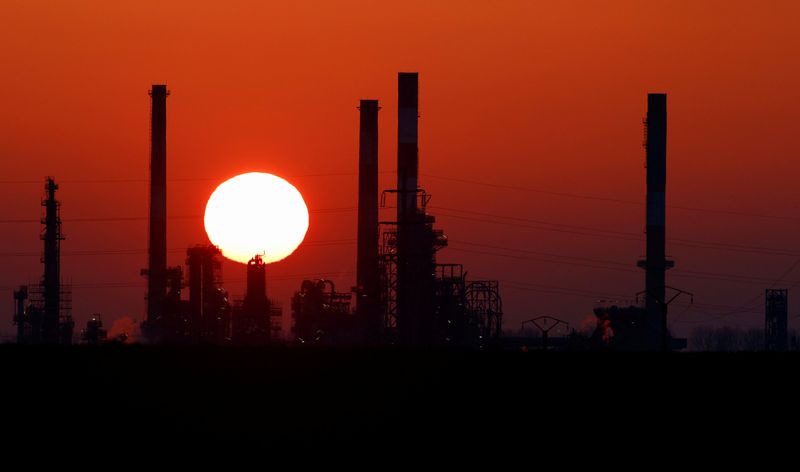Commodities
Oil prices post 3% annual decline, slipping for second year in a row

By Georgina McCartney
HOUSTON (Reuters) -Oil prices fell around 3% in 2024, slipping for a second straight year, as the post-pandemic demand recovery stalled, China’s economy struggled, and the U.S. and other non-OPEC producers pumped more crude into a well-supplied global market.
futures on Tuesday, the last trading day of the year, settled up 65 cents, or 0.88%, to $74.64 a barrel. U.S. West Texas Intermediate (WTI) crude settled up 73 cents, or 1.03%, to $71.72 a barrel.
The Brent benchmark settled down around 3% from its final 2023 closing price of $77.04, while WTI was roughly flat with last year’s final settlement.
In September, Brent futures closed below $70 a barrel for the first time since December 2021, and this year Brent broadly traded under highs seen in the past few years as the post-pandemic demand rebound and price shocks of Russia’s 2022 invasion of Ukraine began to fade.
Oil will likely trade around $70 a barrel in 2025 on weak Chinese demand and rising global supplies, offsetting OPEC+-led efforts to shore up the market, a Reuters monthly poll showed on Tuesday.
A weaker demand outlook in China in particular forced both the Organisation of the Petroleum Exporting Countries and the International Energy Agency (IEA) to cut their oil demand growth expectations for 2024 and 2025.
The IEA sees the oil market entering 2025 in surplus, even after OPEC and its allies delayed their plan to start raising output until April 2025 against a backdrop of falling prices.
U.S. oil production rose 259,000 barrels per day to a record high of 13.46 million bpd in October, as demand surged to the strongest levels since the pandemic, data from the U.S. Energy Information Administration (EIA) showed on Tuesday.
Output is set to rise to a new record of 13.52 million bpd next year, the EIA said.
ECONOMIC, REGULATORY OUTLOOK
Investors will be watching the Federal Reserve’s interest rate-cut outlook for 2025 after Fed bank policymakers this month projected a slower path due to stubbornly high inflation.
Lower interest rates generally spur economic growth, which feeds energy demand.
Some analysts still believe supply could tighten next year depending on President-elect Donald Trump’s policies, including those on sanctions. He has called for an immediate ceasefire in the Russia-Ukraine war, and he could re-impose a so-called maximum pressure policy toward Iran, which could have major implications for oil markets.
“With the possibility of tighter sanctions on Iranian oil with Trump coming in next month, we are looking at a much tighter oil market going into the new year,” said Phil Flynn, a senior analyst for Price Futures Group, also citing firming Indian demand and recent stronger Chinese manufacturing data.
China’s manufacturing activity expanded for a third-straight month in December, though at a slower pace, suggesting a blitz of fresh stimulus is helping to support the world’s second-largest economy.
Buoying prices on Tuesday, the U.S. military said it carried out strikes against Houthi targets in Sanaa and coastal locations in Yemen on Monday and Tuesday.
The Iran-backed militant group has been attacking commercial shipping in the Red Sea for more than a year in solidarity with Palestinians amid Israel’s year-long war in Gaza, threatening global oil flows.

Meanwhile, oil stocks fell last week while fuel inventories rose, market sources said, citing American Petroleum Institute figures on Tuesday.
Crude stocks fell by 1.4 million barrels in the week ended Dec. 27, the sources said on condition of anonymity. Gasoline inventories rose by 2.2 million barrels, and distillate stocks climbed by 5.7 million barrels, they said.
Commodities
Oil prices rise; U.S. crude inventories plunge, Russia-Ukraine truce eyed
Commodities
India’s Reliance to stop buying Venezuelan oil over US tariffs, sources say
Commodities
Oil prices climb on Venezuela supply worries

 Forex3 years ago
Forex3 years agoForex Today: the dollar is gaining strength amid gloomy sentiment at the start of the Fed’s week

 Forex3 years ago
Forex3 years agoUnbiased review of Pocket Option broker

 Forex3 years ago
Forex3 years agoDollar to pound sterling exchange rate today: Pound plummeted to its lowest since 1985

 Forex3 years ago
Forex3 years agoHow is the Australian dollar doing today?

 Cryptocurrency3 years ago
Cryptocurrency3 years agoWhat happened in the crypto market – current events today

 World3 years ago
World3 years agoWhy are modern video games an art form?

 Commodities3 years ago
Commodities3 years agoCopper continues to fall in price on expectations of lower demand in China

 Economy3 years ago
Economy3 years agoCrude oil tankers double in price due to EU anti-Russian sanctions























